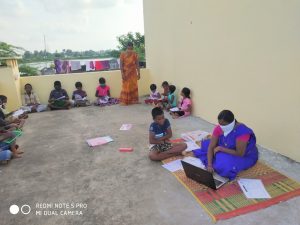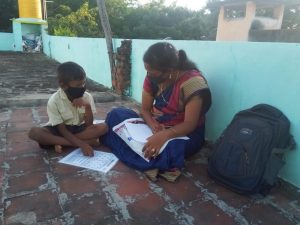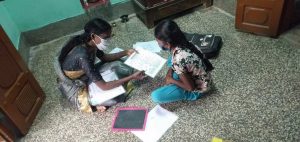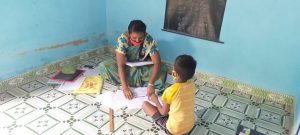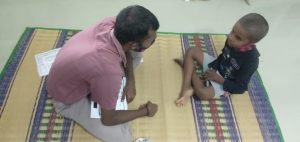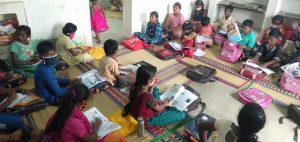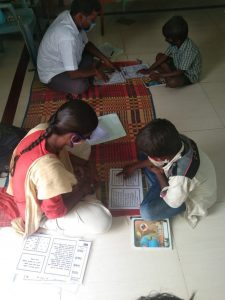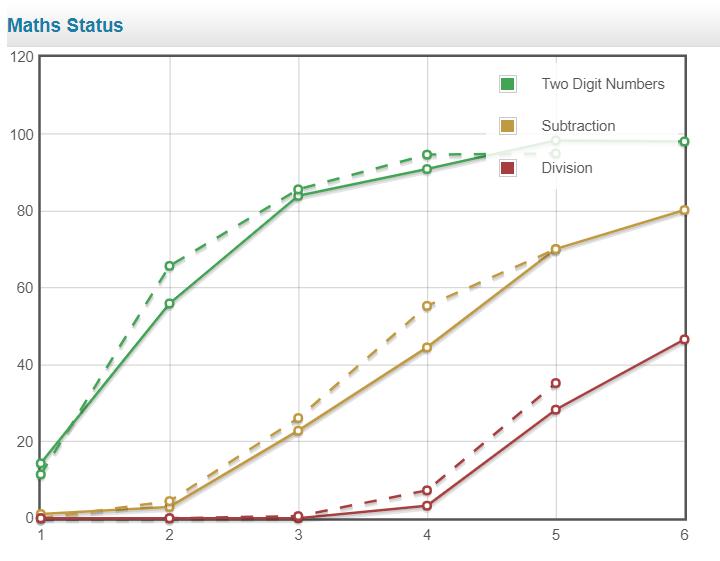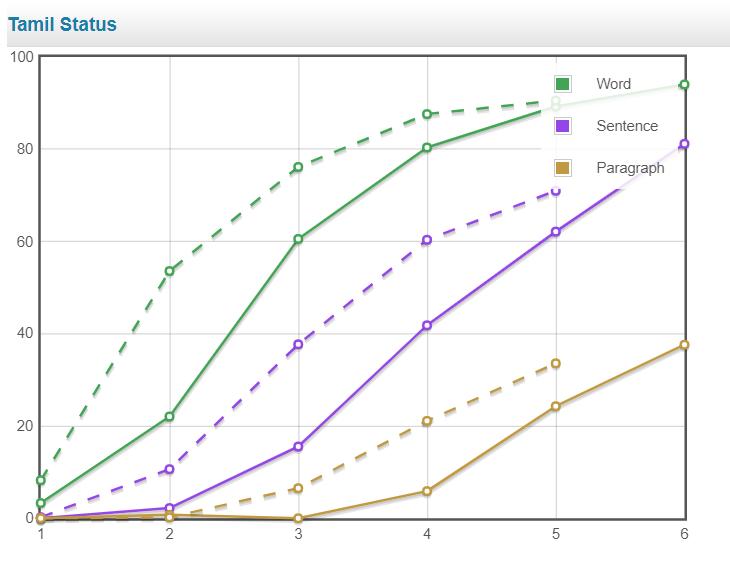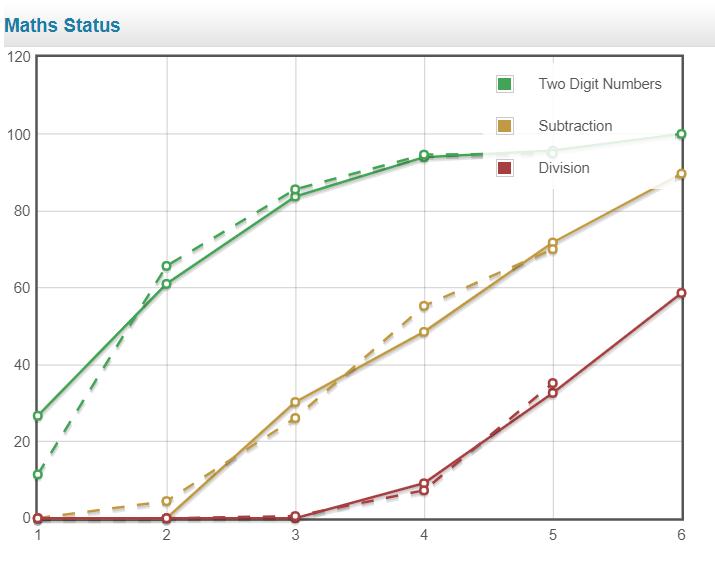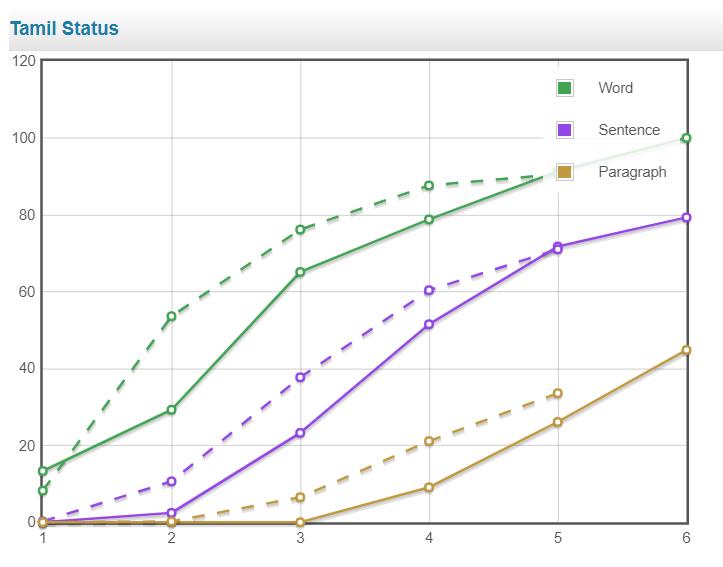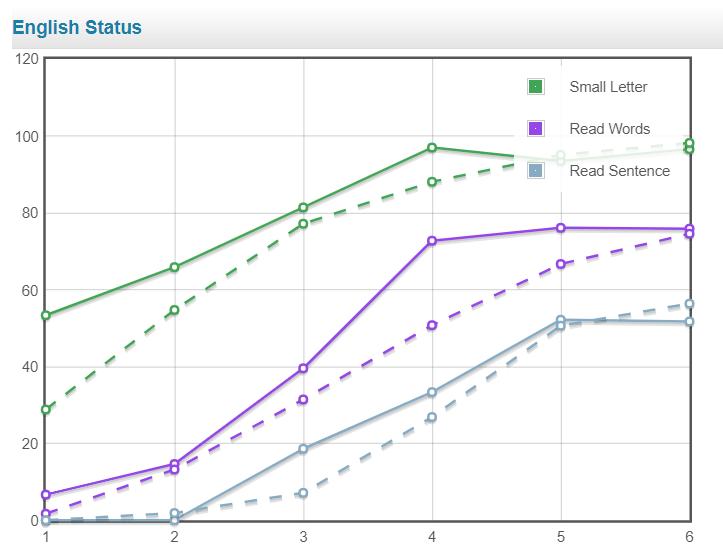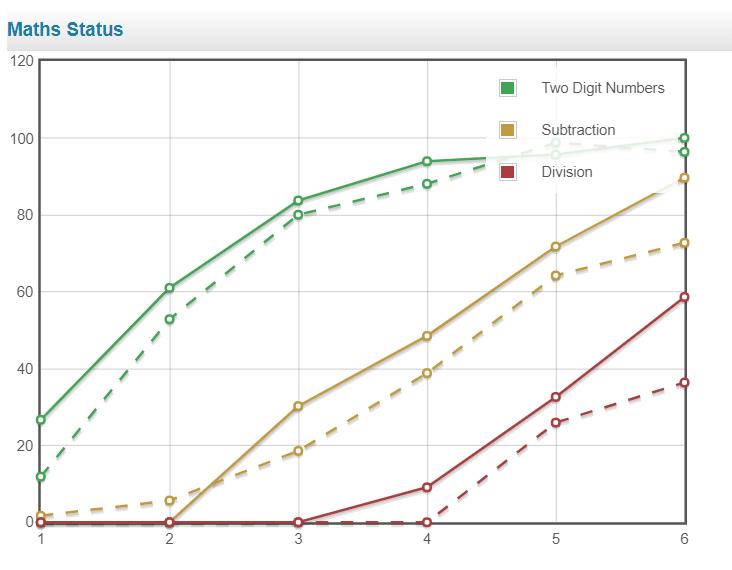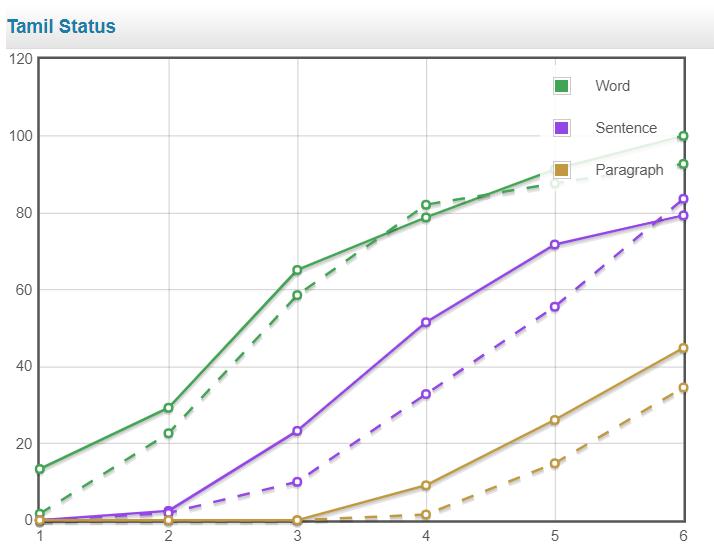Asha Chennai conducted oral assessments at all the mini-schools we were running in Nov 2020 with specific goal of understanding the effectiveness of our mini-schools in stopping the slide in education.
-
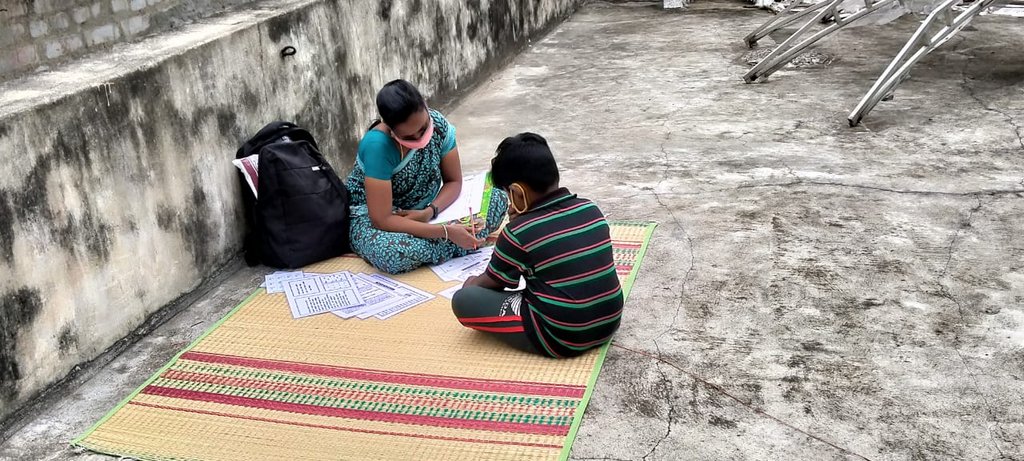
Background
Asha Chennai has been conducting assessments at all the schools that we support every year for the last several years. Read about our rationale for the assessments and how we conduct them in 2016 oral assessment report. You can also read the 2019 oral assessment report.
2020-21 to say the least has been an unusual academic year. Schools all over India closed in March 2020 and have not opened yet. The nature of Asha Chennai’s work also changed significantly because of this. As we could not support these schools, we started mini-schools across all our project areas starting from June. Visit our mini-schools page to see details about these as well as reports on their activities.
Click here to see more photos from the Oral assessment 2020.
Goals of the Oral Assessment 2020
Mini-schools were running informally. The initial intention was to keep the children in touch with education and strengthen their conceptual understanding while we wait for the schools to reopen. As the schools remained closed for months together, we started covering portions from their current year curriculum. This itself made it a challenge to define what exactly are we assessing.
In November, while there were about 45 mini-schools running across Tamilnadu, there were many variations between them. Some schools started as early as June 3rd. There were still schools that were starting in November when we conducted the oral assessments. Not all the schools catered to children from schools that we had supported earlier. We were catering to children from these government schools as well as children from other government schools, government aided school and private schools. While most of the government school children weren’t getting anything in terms of education outside of our mini-schools, some of the private school children were having classes online etc. as well.
There was also wide variation in the facilities available at these mini-schools. Some of them were taking place in the schools themselves where the teacher had access to black boards, good space, mats, educational kits that Asha and the government had given to the school over the years etc. But many mini-schools were makeshift arrangement in teachers’ homes with just a wall-hanging black sheet to serve as a blackboard. Even access to the worksheets we had created was not uniform across our mini-schools because of poor access to photocopying facilities.
Therefore, comparing mini-schools to identify which was doing well and which needed improvement was not going to be easy. However, there were other goals that would be easier to measure. We conducted the oral assessments with the following goals in mind.
- For students that are from Asha supported school, for whom we have conducted assessments last year, we can compare the results. This will help us see if the individual students have progressed from last year.
- For children that have been in our mini-schools for more than a minimum period (say 3 months) at the time of the oral assessment, we can compare the average achievement levels for different classes with similar scores for 2019-20 across our supported schools. This will help us check whether the mini-schools are able to teach as much to children as the typical schools do during regular school years.
- We have never tested any private school or govt aided school children. This gives us an opportunity to compare the children in the same villages who go to private or govt aided schools against those going to govt schools.
- Like previous years, we can once again collect student data like father’s education, mother’s education, details of their preschool education, attendance, height, weight, date of birth etc. This will help us continue our analysis and understanding of sociological factors affecting education and it will also help us understand these factors in the context of students going to private schools.
We decided to go ahead with the oral assessments and collect all of the above data.
Oral Assessments 2020-21
Click here to see all the photos from these assessments.
We conducted the Oral assessments at a total of 47 mini-schools. The coverage for various projects is as follows,
Project Sangamam (Thiruvallur Dists) – 28 mini-schools.
Project Pearl (Thoothukudi Dist) – 7 mini-schools.
Project Thulasi (Viluppuram/Thiruvannamalai Dists) – 9 mini-schools.
Project Poorna Vidhya (Chennai) – 3 mini-schools.
Total – 47 mini-schools.Unlike the previous years, volunteers didn’t travel to the project sites to personally train the teachers and oversee the conduct of the assessments. This was difficult because of the Covid situation. Thankfully we had senior teachers in every project who had conducted the assessment for at least a couple of years. The teachers conducted the assessment in pairs with always a senior teacher as part of the pair.
The assessments were conducted between November 18th and 25th at all the schools. Here are some pictures from Sangamam (Thiruvallur).
-
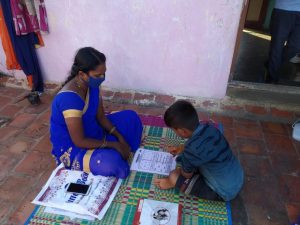
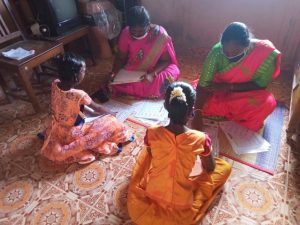
Here are some photos from Pearl (Thoothukudi).

Result Analysis
Data from our oral assessments are uploaded to our server. We have developed tools to perform basic analysis on this data. Contact us if you would like to work with this data. Here is some basic information from the analysis.
Have our Mini-schools arrested the slide in education?
We started out by comparing all the children in our mini-schools against all the children in the schools we were supporting last year. Here is the comparison for English, Maths and Tamil.
Note that the numbers in the X-axis are the classes 1 to 6. The numbers in the Y-axis are the percentage of the student who have that skill. The different coloured lines represent the different skills which are identified in the legend in the top right-hand corner. Finally, the dotted line represents the students last year and the plain line represents the children this year. As you can see there has been a big drop in the levels of the children in English and Tamil at all levels. Also, if you compare the levels of the children in one class last year against the children who are one class higher this year, you see that there has been very little progress! This progress would well have been achieved in the period between Nov 2019 and Mar 2020.
But one key thing to note is that the mini-schools didn’t all start in June. It does not make sense to compare students that have started only in October or November (i.e. who have had just 1 or 2 months of education before the oral assessment) against the children last year. Here is the break up of the children by the month when they started coming to the mini-school.
Month
No of Students
June
137
July
33
August
65
September
263
October
215
November
145
TOTAL
860 (2 Unknown)
Here is another comparison between all the students of 2019-20 but this time with just the mini-school students who have been coming for more than 3 months at the time of the assessment. i.e. They have been coming from before Aug 15th.
As you may notice the difference between the last year and this year students have mostly vanished for English and Maths. There is still a difference in Tamil. Some of this will be attributable to the fact that there are some private school students in our mini-schools. They tend to be stronger than the govt school students in English and weaker in Tamil.
How are the Mini-school students learning?
In the last section we were comparing the mini-schools with how students at all schools fared last year. Coming specifically to the mini-schools themselves, how are the students progressing. One easy comparison was to compare children who have been in the mini-schools from before Aug 15th to those who are coming after Sept 15th. This will reveal how the mini-schools are able to improve the levels of the children. Here is that comparison.
Here the plan line represents children who have been coming for more than 3 months and the dotted lines children who have been coming for less than 2 months. As you can see, in every subject and level, the students who have been coming for more than 3 months have done better.
Another interesting comparison was to see how an individual student’s level has changed from the last year’s assessment. We have this information only for the subset of students who went to an Asha supported school last year and also was present during the oral assessment. The picture becomes clear when you see this information by the month below.
Month | English | Maths | Tamil |
| June | Improved – 15 Regressed – 9 Maintain – 28 | Improved – 21 Regressed – 11 Maintain – 20 | Improved – 9 Regressed – 13 Maintain – 30 |
| July | Improved – 6 Regressed – 4 Maintain – 10 | Improved – 10 Regressed – 3 Maintain – 7 | Improved – 8 Regressed – 2 Maintain – 10 |
| August | Improved – 7 Regressed – 7 Maintain – 11 | Improved – 10 Regressed – 5 Maintain – 10 | Improved – 4 Regressed – 8 Maintain – 13 |
| September | Improved – 37 Regressed – 39 Maintain – 55 | Improved – 52 Regressed – 21 Maintain – 58 | Improved – 39 Regressed – 31 Maintain – 61 |
| October | Improved – 14 Regressed – 31 Maintain – 35 | Improved – 22 Regressed – 18 Maintain – 40 | Improved – 17 Regressed – 25 Maintain – 38 |
| November | Improved – 7 Regressed – 21 Maintain – 30 | Improved – 13 Regressed – 15 Maintain – 30 | Improved – 11 Regressed – 12 Maintain – 35 |
The colours indicate whether the number of people who have improved outnumber the number of people who have regressed.
- Dark green – Greater by more than 50%.
- Light green – Greater by less than 50%.
- Light red – Lesser by less than 50%.
- Dark red – Lesser by greater than 50%.
Tamil scores for children who started in June seems to be an aberration. Other than that, there is a clear pattern that can be seen. Children who started the mini-schools earlier have improved upon their oral scores and children who have started later have regressed. This is more pronounced in English which being a more difficult subject for the children takes more concerted learning. Recovering to the old learning level and improving seems to be happening more easily in Maths. It is also because our curriculum has placed greater emphasis on basic Mathematics. Tamil being their mother tongue and with the variations introduced due to private school children etc., is less well behaved.
Conclusion
It needs to be pointed out that mini-schools have functioned under several challenges. The schools did not all start in June and we adjusted for that in our comparison. Some of the other challenges are which couldn’t be factored in are,
- Some of the mini-schools shutdown and restarted because of Covid fear. This kind of 1 or 2 week break is not factored in.
- People take schools more seriously than mini-schools. Children often travel with their parents for a couple of weeks and do not come to the mini-school. Attendance therefore tends to be poor.
- There is also a broader churn in the children attending the mini-school. Children from one hamlet stop attending and from another hamlet start coming. The impact on the child that joined late is factored in. But even the children who have been continuing uninterrupted are impacted. The teacher will need to focus on the new entrants and go back to a lower level to be able to engage them.
Despite these challenges, mini-schools have been able to educate the children who are attending. Children who have spent at least 3 months in the mini-schools have learnt as much as the children would have in a normal school even though the mini-schools are functioning only for 2 to 3 hours!


